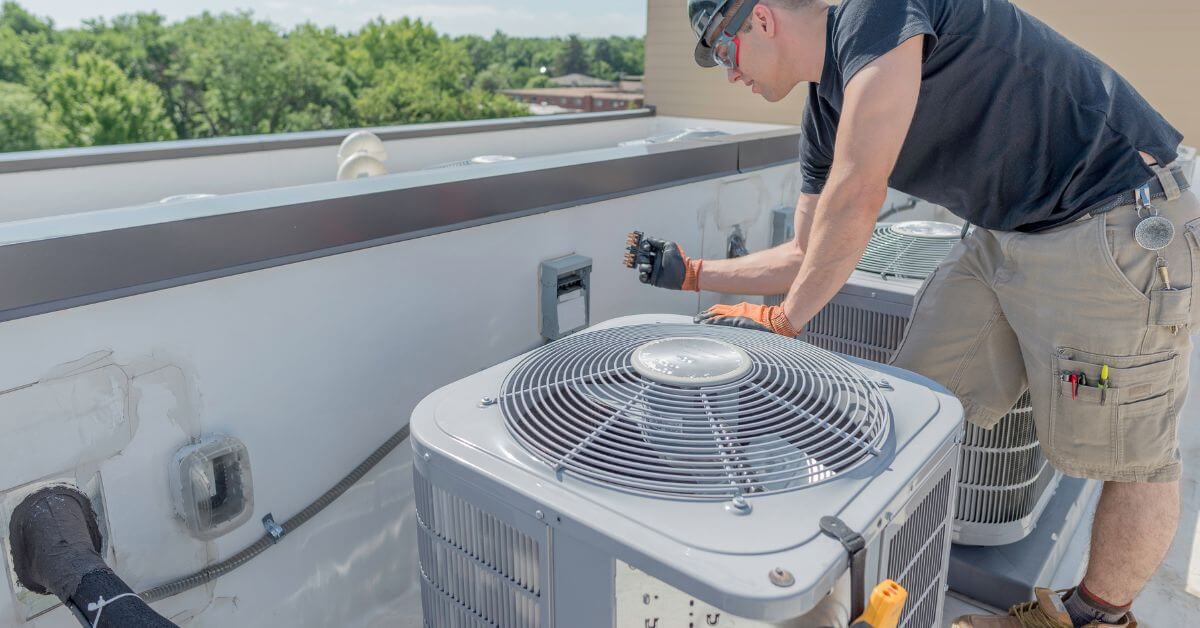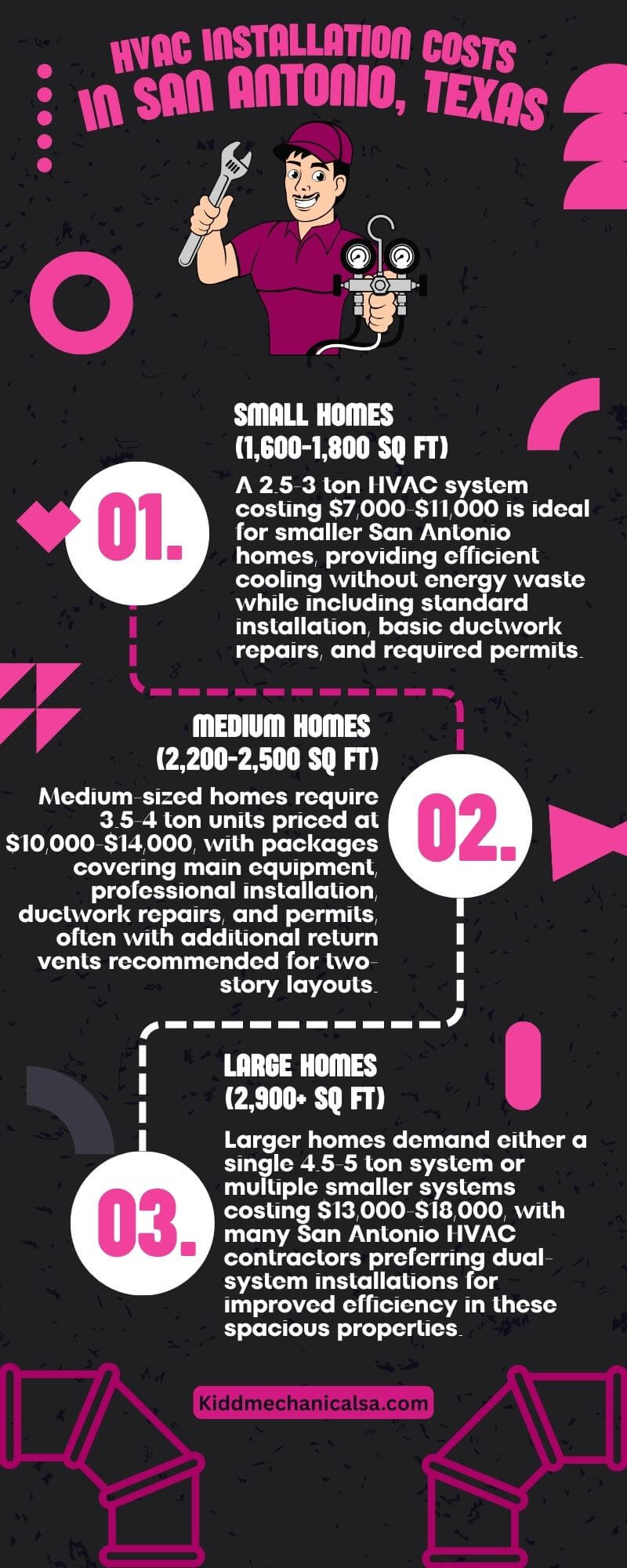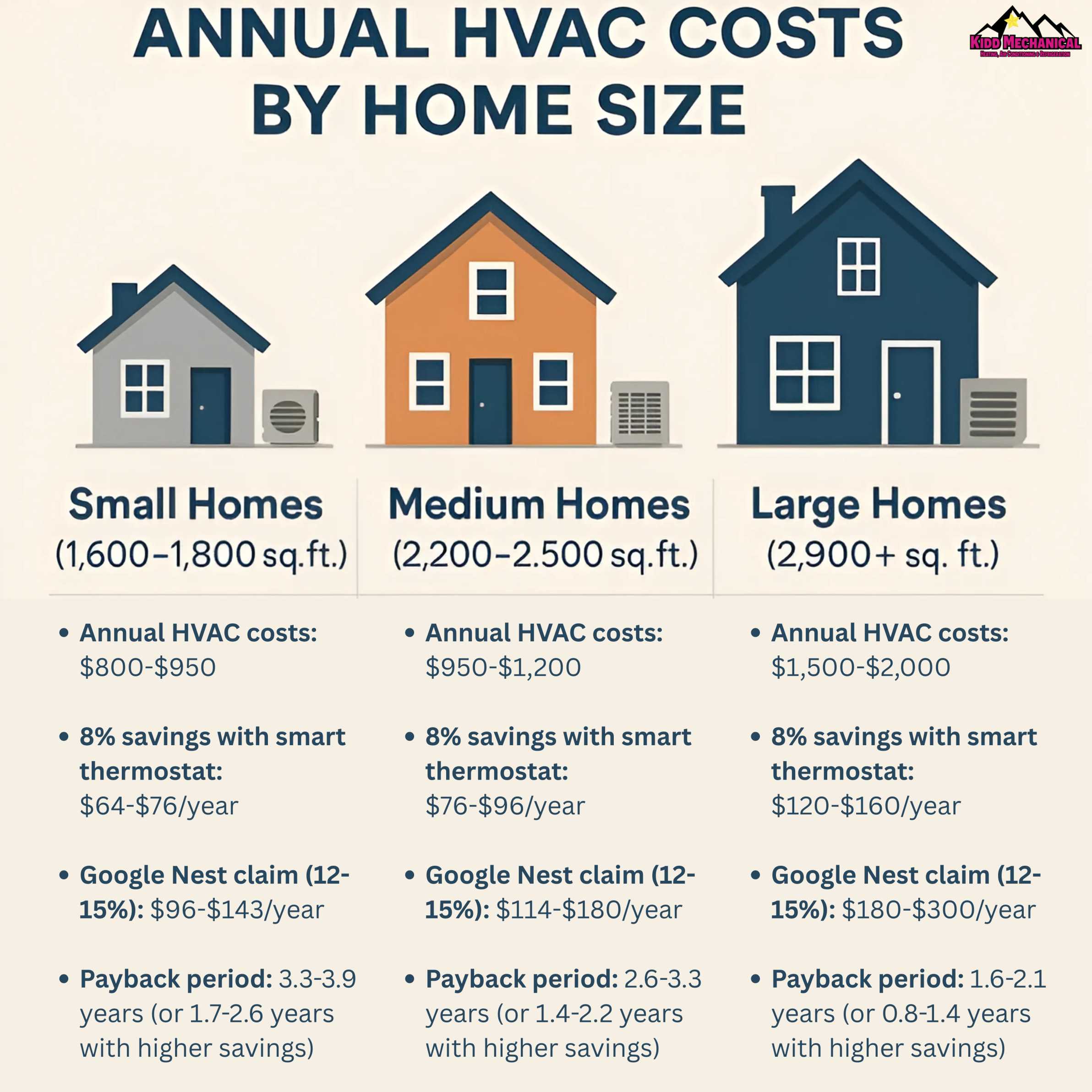
San Antonio saw some of its hottest days in 2023 and 2024, with average temperatures entering triple-digit territory for several days during the peak of summer. It's understandable if you’re looking to get a new HVAC system that cools better while also ensuring energy savings. As reputable HVAC contractors in San Antonio, we can guide you about the HVAC system costs, options to save money, and which kind of system will fit your home size. So, let’s get into it:
The average size of homes in San Antonio (2175 sqft) is the third highest among US major cities, and almost 550 square feet larger than the national average of 1,632. Breakdown of different house sizes in San Antonio include:
We’ll calculate HVAC Installation cost in San Anotnio based on these sizes so you can get a general idea of how much it might cost for your home.

For smaller homes in San Antonio, you'll typically need a 2.5-3 ton HVAC unit. Most HVAC contractors in San Antonio recommend this size for proper cooling without wasting energy. These systems handle about 400-600 square feet per ton.
Your basic package includes:
Most small homes don't need anything bigger than a 3-ton unit. Going too big wastes money and creates humidity problems in your home.
Medium-sized homes need more cooling power. You're looking at 3.5-4 ton units to handle the extra square footage. A 3-ton system typically costs $9,000-$12,000 depending on which brand you choose.
The package covers:
Medium homes often have two-story layouts, which can create temperature differences between floors. Your HVAC contractor in San Antonio might suggest additional return vents to improve airflow.
Bigger homes need serious cooling power. You'll need either a large 4.5-5 ton system or multiple smaller systems. Many HVAC contractors in San Antonio actually prefer installing two systems for homes this size to improve efficiency.
A 4-ton system alone typically runs $11,000-$14,000. Your package includes:
Remember these prices don't include extras like complete ductwork replacement (adds $5,000-$12,000), high-efficiency upgrades (adds $1,000-$3,500), smart HVAC features (adds $3,000-$8,000), or zoning systems. These all cost extra.
Home Size | HVAC Unit Size | Cost Range | Key Package Components |
Small Homes (1,600-1,800 sq ft) | 2.5-3 ton | $7,000-$11,000 | - Furnace + AC or heat pump system - Standard professional installation - Basic ductwork repairs - City permits |
Medium Homes (2,200-2,500 sq ft) | 3.5-4 ton | $10,000-$14,000 | - Main equipment (furnace/heat pump) - Professional installation - Basic ductwork repairs - Necessary permits |
Large Homes (2,900+ sq ft) | 4.5-5 ton or multiple systems | $13,000-$18,000 | - Premium equipment - Complete professional installation - Ductwork repairs and balancing - Permits and inspections |
No, a bigger AC unit won't necessarily cool your house better. Oversized units cool too quickly, causing short-cycling - turning on and off frequently without properly dehumidifying the air. This creates clammy, uncomfortable conditions and increases wear on the system.
The correct size AC unit should run for longer cycles to effectively remove humidity and maintain even temperatures. A properly sized unit will:
An HVAC professional should perform a Manual J calculation to determine the right size for your home, taking into account square footage, insulation, windows, ceiling height, and local climate conditions.
Smart thermostats typically cost between $130-$280, with premium models like Google Nest priced at $240-$280. Installation can be DIY or professional ($100-$150), bringing total costs to $130-$430.
The Energy Star indicates you can save approximately 8% annually on heating and cooling by adjusting your thermostat 7°-10°F for 8 hours daily.
Premium smart thermostats like Google Nest claim higher savings of 12% on heating and 15% on cooling.

First lets establish average HVAC yearly energy costs in the San Antonio area. According to the 2009 EIA Residential Energy Consumption Survey, the average annual electricity cost per Texas household was $1,801, with HVAC systems accounting for about 40% of home energy use (18% cooling, 22% heating).
This would suggest average annual HVAC costs of approximately $720. More recent data from Energy Texas (February 2025) shows average monthly electricity costs of $179 ($2,148 annually), suggesting current HVAC costs around $859 annually using the same 40% proportion.
Our estimates are adjusted to align more closely with the Energy Texas data while still accounting for variations by home size. For small and medium homes, costs fall within a range consistent with the $859 annual average, while larger homes typically experience higher costs due to greater cooling and heating requirements and potentially older, less efficient systems.
That said, let’s see how much you’ll potentially save on annual HVAC costs by installing smart thermostats:

Small Homes (1,600-1,800 sq ft)
Medium Homes (2,200-2,500 sq ft)
Large Homes (2,900+ sq ft)
Smart thermostats control the entire system as one unit and cannot direct airflow to specific rooms.
They create schedules based on time of day, offer remote control via smartphone, and learn basic home occupancy patterns, but cannot create different temperature zones without additional hardware.
For reference, complete smart HVAC systems cost $3,000-$8,000 above basic installation, offering 15-35% energy savings through room-by-room control, but require 4.5-19.6 years to pay back the investment.
Smart thermostats deliver substantial energy savings with minimal upfront cost and typically pay for themselves within 1-3 years, making them a more accessible upgrade for most homeowners on a budget and no need for added benefits a complete smart system offers like CO2 detection, motion detection control and so on.
SEER (Seasonal Energy Efficiency Ratio) measures an air conditioner's cooling efficiency. It calculates the total cooling output divided by the total electric energy input during a typical cooling season.
As per Energy.Gov, a SEER 14 upgrade from SEER 9 for a central air conditioner can potential lead to monthly savings of up to $35 per $100 spent, which translate to $420 in annual savings potential.
Always have a professional HVAC contractor in San Antonio TX perform a comprehensive home assessment to determine the most cost-effective SEER rating for your specific needs.
If you’ve decided to get a new HVAC system, Kidd Mechanical is one of the top-notch HVAC contractors in San Antonio, and we can help you select the right tonnage depending on your home size, the right brand depending on your budget and usage needs, and the right features depending on your comfort preferences.
So call 210-589-2292 to get a quick consultation and have your new HVAC installed before those temps hit triple digits.
A 3-ton air conditioner can cool approximately 1,500 to 1,800 square feet. The general rule is that 1 ton of cooling covers 500 to 600 square feet, depending on insulation, climate, and ceiling height. Proper load calculation ensures efficiency and comfort in cooling larger or more complex spaces.
In 100°F weather, your AC should keep your home about 20°F cooler than the outdoor temperature. Most systems are designed to maintain indoor temperatures around 75°F to 80°F in extreme heat. If it struggles to reach that range, the unit may be undersized or need maintenance.
A 2.5-ton air conditioner can cool approximately 1,250 to 1,500 square feet. The general guideline is that 1 ton of cooling covers 500 to 600 square feet, though actual performance depends on insulation, ceiling height, and climate conditions.
A new AC unit for a 1,500 sq ft house typically costs between $5,500 and $7,500, including installation. Costs vary based on unit efficiency, brand, and whether ductwork is needed. A mid-range 2.5-ton unit is usually sufficient for this size and balances performance with energy savings.
HVAC systems are expensive right now due to supply chain disruptions, rising material costs, increased labor rates, and new efficiency regulations. Global shortages of components like semiconductors and refrigerants have also driven up prices. These factors combined have raised installation and equipment costs significantly.
